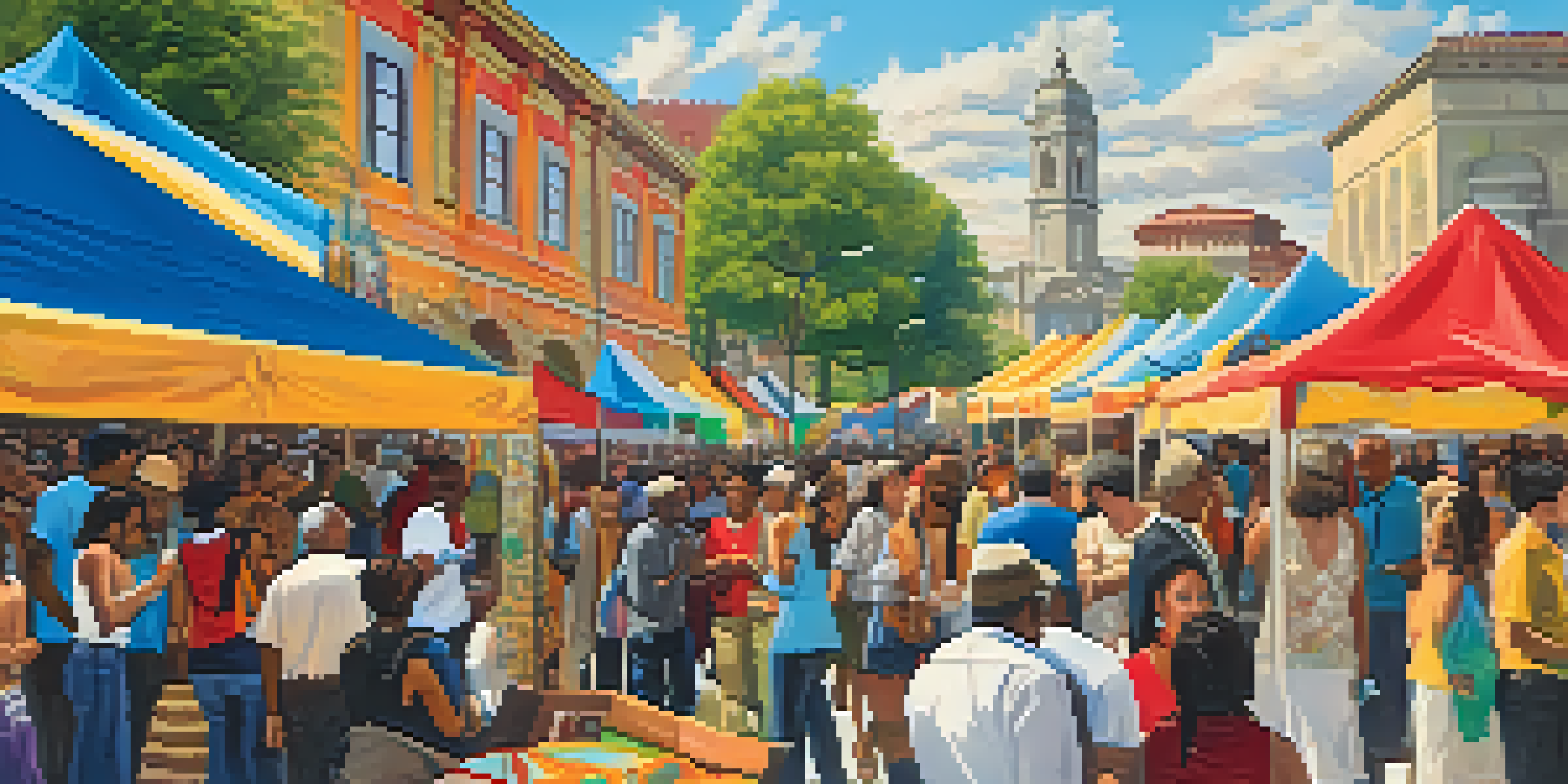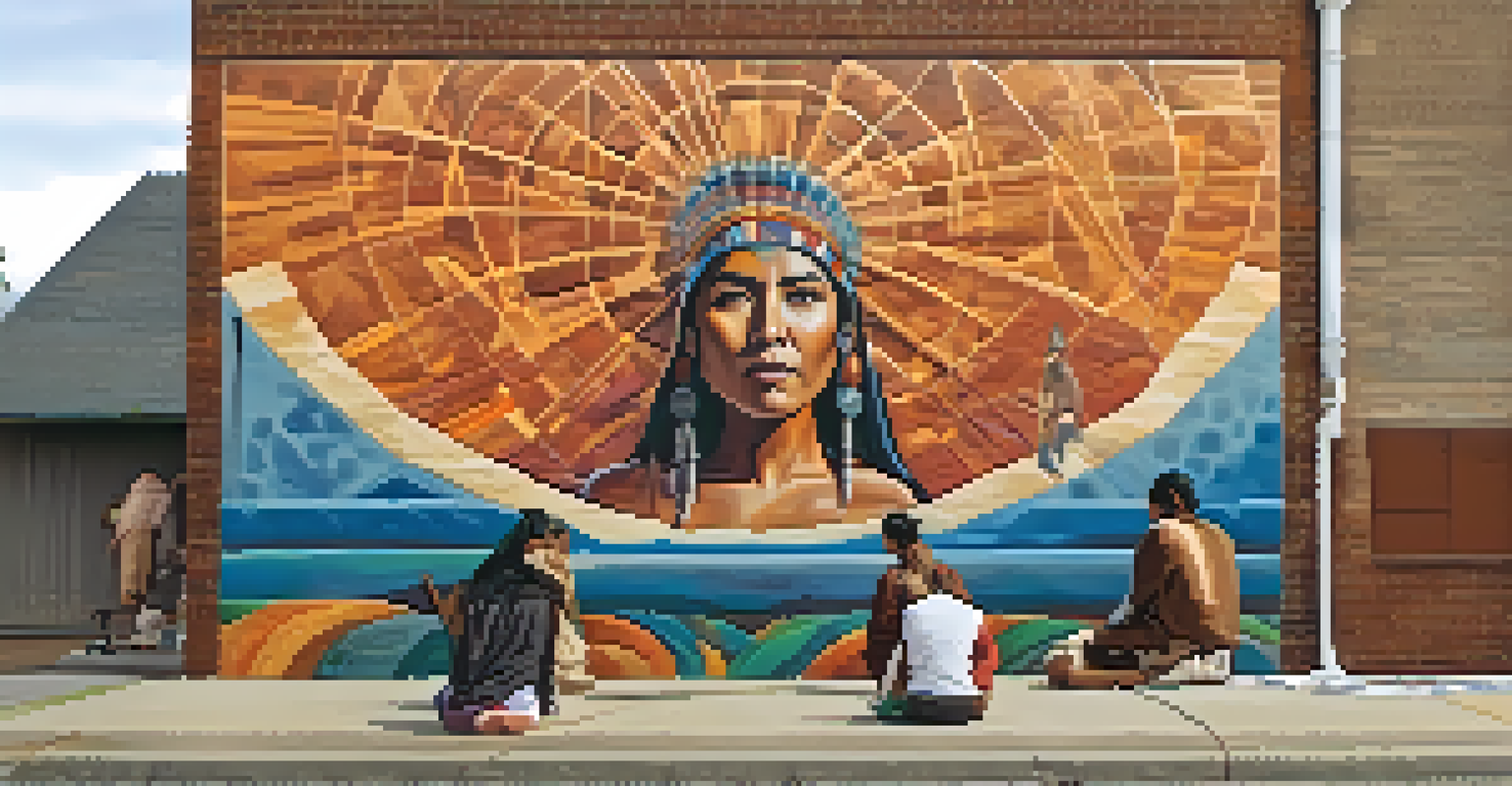Using Visual Arts to Promote Intercultural Understanding

The Power of Visual Arts in Communication
Visual arts serve as a universal language, transcending spoken words. Through painting, sculpture, and photography, artists convey emotions and ideas that resonate across cultures. This visual communication can often express complex themes that might be difficult to articulate verbally, creating an immediate connection among diverse audiences.
Art is the most beautiful of all lies.
When people engage with visual art, they often find common ground in shared feelings and experiences. For instance, a powerful photograph depicting a community's struggle can evoke empathy regardless of the viewer's background. This emotional resonance is key to fostering understanding between different cultures.
Moreover, visual arts can challenge stereotypes and misconceptions. By showcasing authentic representations of various cultures, artists can dismantle preconceived notions and encourage viewers to rethink their perspectives, fostering a more inclusive world.
Art Exhibitions as Cultural Bridges
Art exhibitions offer a unique platform for artists from different backgrounds to showcase their work. These events not only highlight diverse artistic expressions but also invite dialogue among attendees about cultural differences and similarities. When visitors engage with artworks from various cultures, they gain insights into those cultures' values and histories.

For example, a multicultural art festival can feature artists from around the globe, each sharing their unique narratives through their art. As attendees explore these narratives, they are exposed to a variety of perspectives, fostering intercultural understanding and respect.
Art as a Universal Language
Visual arts transcend spoken words, creating emotional connections and fostering understanding across diverse cultures.
Furthermore, exhibitions can also include workshops and discussions led by artists, allowing for deeper interactions. These experiences create opportunities for attendees to ask questions and share their own stories, enriching the overall understanding of the cultures represented.
Art as a Tool for Social Change
Visual arts often reflect societal issues, making them powerful tools for social change. Artists can use their platforms to address topics such as inequality, migration, and cultural identity, prompting conversations that bridge cultural divides. By focusing on shared challenges, art can unify people from various backgrounds.
The role of the artist is to ask questions, not to answer them.
Take, for example, street art that addresses social justice. Murals can convey messages of hope, resistance, and solidarity, drawing attention to issues affecting specific communities while resonating with broader audiences. This can inspire collective action and solidarity among diverse groups.
In this way, art becomes a catalyst for understanding and empathy, encouraging people to look beyond their own experiences. When individuals see their struggles reflected in someone else's art, it cultivates a sense of shared humanity that transcends cultural barriers.
The Role of Education in Promoting Intercultural Arts
Education plays a crucial role in integrating visual arts into discussions about culture and diversity. Schools and community programs can introduce students to various artistic traditions, encouraging them to appreciate and respect different cultures. This early exposure lays the groundwork for a more inclusive worldview.
Art education can also foster collaboration among students from diverse backgrounds. Projects that involve creating art together can break down barriers, allowing students to learn from one another while expressing their unique perspectives. These experiences can lead to friendships that bridge cultural gaps.
Exhibitions Foster Cultural Dialogue
Art exhibitions serve as platforms for intercultural exchange, allowing attendees to engage with diverse artistic narratives.
Additionally, teaching about the historical and cultural contexts of different art forms enhances understanding. When students learn about the stories behind the art, they develop a deeper appreciation for the cultures that created them, ultimately promoting intercultural dialogue.
Digital Art and Global Connectivity
In our increasingly digital world, visual arts have expanded beyond traditional mediums, allowing for global connectivity. Artists can share their work on social media platforms, reaching audiences worldwide. This digital accessibility invites conversations about cultural exchange and mutual understanding.
For instance, online art competitions and exhibitions can showcase talents from diverse backgrounds, creating a virtual space for intercultural dialogue. Viewers from different parts of the world can engage with the artwork and discuss its themes, fostering connections that may not have been possible otherwise.
Moreover, digital art can incorporate elements from various cultures, resulting in innovative, hybrid forms of expression. This blending of styles not only reflects globalization but also highlights the beauty of cultural diversity, inviting viewers to appreciate art from a broader perspective.
Cultural Representation in Visual Arts
Cultural representation in visual arts is vital for promoting understanding and respect. When artists from marginalized communities create works that reflect their experiences, they provide valuable insights into their cultures. This representation allows for a more nuanced understanding of diversity, challenging stereotypes and fostering empathy.
For example, Indigenous artists using traditional techniques to tell their stories can educate viewers about their history and contemporary issues. This not only honors their heritage but also invites audiences to reflect on their own cultural narratives, creating a dialogue between different communities.
Education Promotes Cultural Appreciation
Integrating visual arts into education enhances respect for cultural diversity and encourages collaboration among students from various backgrounds.
Additionally, diverse representation in art can inspire emerging artists from underrepresented backgrounds. When they see their cultures reflected in the art world, it empowers them to express their identities and share their stories, further enriching the intercultural dialogue.
The Future of Visual Arts in Intercultural Understanding
As the world becomes more interconnected, the role of visual arts in promoting intercultural understanding will continue to grow. Artists will increasingly use their platforms to address global issues, encouraging empathy and collaboration among diverse communities. The future of art lies in its potential to act as a unifying force in an ever-divided world.
Emerging technologies, such as virtual reality and augmented reality, offer new ways to experience and engage with art. These innovations can create immersive experiences that allow viewers to step into different cultural narratives, fostering deeper connections between audiences and artists.

Ultimately, the visual arts will remain a vital tool in bridging cultural gaps. By fostering dialogue, challenging perceptions, and celebrating diversity, art will continue to play a significant role in cultivating intercultural understanding and harmony.